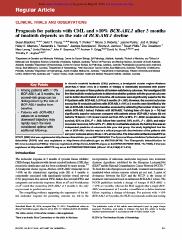Please use this identifier to cite or link to this item:
https://ahro.austin.org.au/austinjspui/handle/1/12227| Title: | Prognosis for patients with CML and >10% BCR-ABL1 after 3 months of imatinib depends on the rate of BCR-ABL1 decline. | Austin Authors: | Branford, Susan;Yeung, David T;Parker, Wendy T;Roberts, Nicola D;Purins, Leanne;Braley, Jodi A;Altamura, Haley K;Yeoman, Alexandra L;Georgievski, Jasmina;Jamison, Bronte A;Phillis, Stuart;Donaldson, Zoe;Leong, Mary;Fletcher, Linda;Seymour, John F;Grigg, Andrew P ;Ross, David M;Hughes, Timothy P | Affiliation: | Department of Haematology, Peter MacCallum Cancer Centre, East Melbourne, Australia University of Melbourne, Parkville, Australia Department of Haematology, Austin Hospital, Melbourne, Australia Department of Haematology, Flinders University and Medical Centre, Bedford Park, Australia Department of Genetics and Molecular Pathology, Centre for Cancer Biology, SA Pathology, Adelaide, Australia School of Pharmacy and Medical Science, University of South Adelaide, Adelaide, Australia School of Medicine, and School of Molecular and Biomedical Science, University of Adelaide, Adelaide, Australia School of Molecular and Biomedical Science, University of Adelaide, Adelaide, Australia Cancer Theme, South Australian Health and Medical Research Institute, Adelaide, Australia Australasian Leukaemia and Lymphoma Group, East Melbourne, Australia School of Medicine, and Department of Haematology, Centre for Cancer Biology, SA Pathology, Adelaide, Australia |
Issue Date: | 23-May-2014 | Publication information: | Blood 2014; 124(4): 511-8 | Abstract: | In chronic myeloid leukemia (CML) patients, a breakpoint cluster region-Abelson (BCR-ABL1) value >10% at 3 months of therapy is statistically associated with poorer outcome, yet many of these patients still achieve satisfactory outcomes. We investigated 528 first-line imatinib-treated patients to determine whether patients with the poorest outcome can be better discriminated at 3 months. All outcomes were significantly superior for the 410 patients with BCR-ABL1 ≤10% at 3 months (P < .001). However, the poorest outcomes among the 95 evaluable patients with BCR-ABL1 >10% at 3 months were identified by the rate of BCR-ABL1 decline from baseline, assessed by estimating the number of days over which BCR-ABL1 halved. Patients with BCR-ABL1 halving time <76 days (n = 74) had significantly superior outcomes compared with patients whose BCR-ABL1 values did not halve by 76 days (n = 21; 4-year overall survival, 95% vs 58%, P = .0002; progression-free survival, 92% vs 63%, P = .008; failure-free survival, 59% vs 6%, P < .0001; and major molecular response, 54% vs 5%, P = .008). By multivariate analysis, the halving time was an independent predictor of outcome in this poor risk group. Our study highlighted that the rate of BCR-ABL1 decline may be a critical prognostic discriminator of the patients with very poor outcome among those >10% at 3 months. The International Randomized IFN vs STI571 (IRIS) trial was registered at http://www.clinicaltrials.gov as #NCT00006343. The Tyrosine Kinase Inhibitor Optimization and Selectivity (TOPS) trial was registered at http://www.clinicaltrials.gov as #NCT00124748. The Therapeutic Intensification in DE-novo Leukaemia (TIDEL) I trial was registered at http://www.ANZCTR.org.au as #ACTRN12607000614493. The TIDEL II trial was registered at http://www.ANZCTR.org.au as #ACTRN12607000325404. | Gov't Doc #: | 24859364 | URI: | https://ahro.austin.org.au/austinjspui/handle/1/12227 | DOI: | 10.1182/blood-2014-03-566323 | Journal: | Blood | URL: | https://pubmed.ncbi.nlm.nih.gov/24859364 | Type: | Journal Article | Subjects: | Antineoplastic Agents.therapeutic use Benzamides.therapeutic use Female Follow-Up Studies Fusion Proteins, bcr-abl.genetics.metabolism Humans Leukemia, Myelogenous, Chronic, BCR-ABL Positive.drug therapy.metabolism.mortality Male Middle Aged Piperazines.therapeutic use Prognosis Pyrimidines.therapeutic use Remission Induction Survival Rate Time Factors |
| Appears in Collections: | Journal articles |
Files in This Item:
| File | Description | Size | Format | |
|---|---|---|---|---|
| 24859364.pdf | 867.41 kB | Adobe PDF |  View/Open |
Page view(s)
16
checked on May 13, 2024
Download(s)
74
checked on May 13, 2024
Google ScholarTM
Check
Items in AHRO are protected by copyright, with all rights reserved, unless otherwise indicated.
